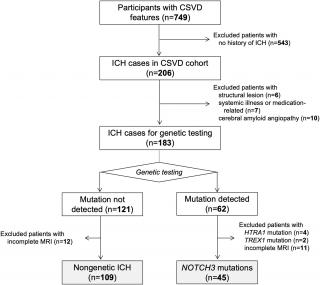Nov, 2022

The NOTCH3 mutation is a common cause of hereditary cerebral small vessel disease (CSVD) and may be a cause of spontaneous intracerebral haemorrhage (ICH). The aim was to investigate the clinical/imaging features for identifying the NOTCH3-mutation-related ICH. The study was based on a cohort of 749 CSVD patients in Taiwan who received next-generation sequencing of CSVD genes including NOTCH3. Patients with a history of ICH (n = 206) were included for analysis. The CSVD neuroimaging markers were compared between the patients with NOTCH3 and those without known genetic mutations. After excluding patients with other causes of ICH (structural lesions, systemic/medication related or amyloid angiopathy) and those without neuroimaging, 45 NOTCH3 mutation patients and 109 nongenetic ICH patients were included. The NOTCH3 mutation patients were more likely to have thalamic haemorrhage, a family history of stroke and more severe CSVD neuroimaging markers. A five-point NOTCH3-ICH score was constructed and consisted of a history of stroke in siblings, thalamic haemorrhage, any deep nuclei lacunae, any hippocampal cerebral microbleed (CMB) and a thalamic CMB >5 (one point for each). A score ≥2 had a sensitivity of 88.9% and a specificity of 64.2% in identifying the NOTCH3 mutation. The NOTCH3 mutation patients had a higher risk of recurrent stroke (9.1 vs. 4.5 per 100 person-years, log-rank p = 0.03) during follow-up. The patients with NOTCH3-mutation-related ICH had a higher burden of CMBs in the hippocampus/thalamus and a higher recurrent stroke risk. The NOTCH3-ICH score may assist in identifying genetic causes of ICH.